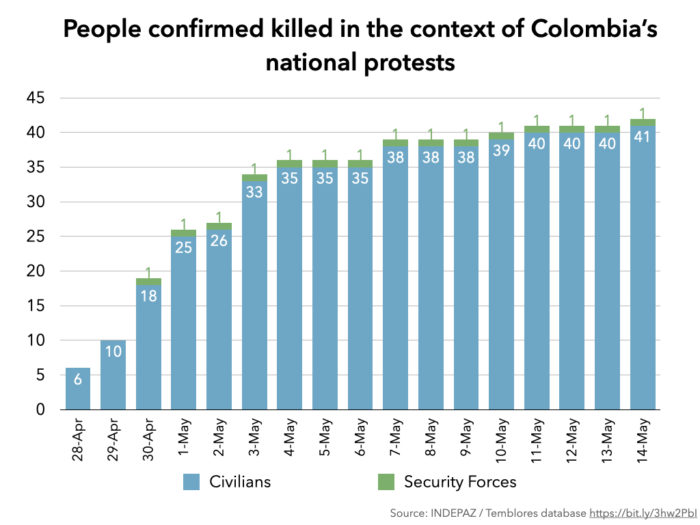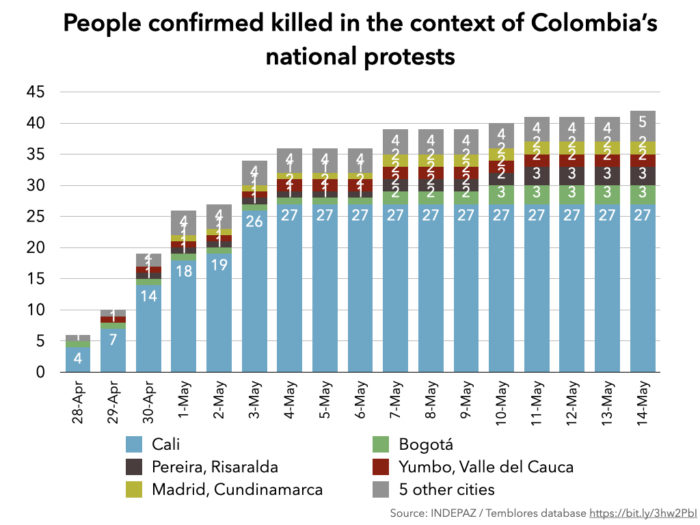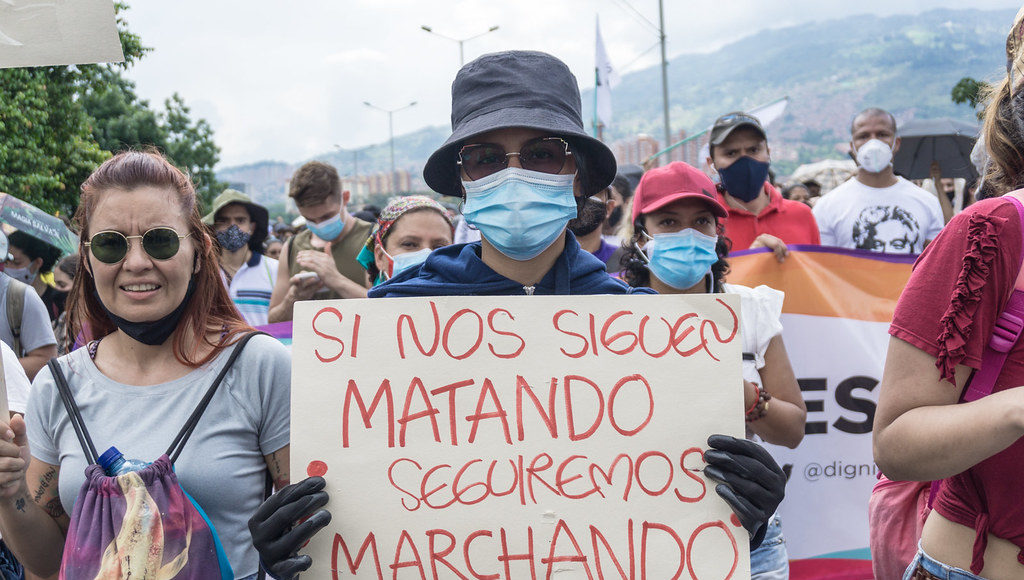Like many of us, Adam Isacson and Gimena Sánchez-Garzoli from WOLA (the Washington Office on Latin America), are saddened and worried to see what Colombia is going through: ‘Only four years ago, the FARC were laying down their weapons and it felt much more like a time of possibility’, Adam states. ‘The present crisis offers renewed possibility, though: through real dialogue. The U.S. government can help by isolating some very powerful people in the country who oppose that, especially in the governing party’. Read Adam’s column published in the New York Times on May 12 and continue on for updates and analysis on the recent nationwide protests.
Violence trends
The security forces’ response to Colombia’s nationwide protests became less lethal over the past week. Three people involved in protests were killed in the 8 days between May 7 and 14, increasing the overall confirmed toll from 39 to 42, according to a database maintained by the non-governmental organisations Temblores and Indepaz.
Heavy, and often outraged, international scrutiny of the police and military response has likely contributed to restraint. So has a reduction in the protests’ overall intensity, as formal negotiations begin. While large turnouts continue in Bogotá, Medellín, and elsewhere, they are not consistently large every single day. Colombia’s southwest, though, remains very active, especially the cities of Cali, Valle del Cauca; Popayán, Cauca; Neiva, Huila; and Pasto, Nariño.

As of 11:30pm on May 12, Temblores had counted 39 killings committed by security forces; 1,055 “arbitrary detentions,” 442 “violent interventions in the framework of peaceful protests” including 133 uses of lethal firearms and 30 protesters suffering eye damage, and 16 cases of sexual violence. Hundreds of people are still missing, with most probably in police custody. Sebastian Lanz, the co-director of Temblores, told Vice that some are being charged with crimes, but others “have ended up in unauthorised ‘clandestine’ detention centres where ‘there is no legal authority to verify the human rights situation there,’” or in “special centres for protection“ where people may be held without charges for up to 12 hours.
Geography of protest
Activity remains widespread geographically. On May 12, the protests’ two-week mark, the Defense Ministry’s “Unified Command Post” counted 170 protest activities in 391 of Colombia’s 1,123 municipalities (counties). That day, Defense Minister Diego Molano said that protesters continued to block 80 roads around the country.
In Cali early in the week, protesters maintained blockades stopping most road traffic in and out of the city. Some of these protesters were members of an Indigenous minga (“coming together”) that brought thousands from Cauca, to the south of Cali, to show solidarity with protesters in Colombia’s third-largest city. The blockades generated reports of shortages of goods in Cali, including gasoline, and an inability to get export cargo to Buenaventura, Colombia’s busiest port.
The Defense Ministry deployed 10,000 police and 2,100 soldiers to Cali. Most road blockades were lifted peacefully, but the military and police used heavy force in Siloé, a neighbourhood in western Cali that has seen many casualties. On May 9, assailants in civilian clothes shot at indigenous protesters in broad daylight, wounding eight. The minga pulled back to Cauca on May 12, citing government plans for “an armed police and paramilitary attack against our delegations” if it stayed in Cali.

A road blockade in Buga, along the Pan-American Highway north of Cali, was the site of bitter, prolonged clashes between protesters and a combined police-military force on May 13. No deaths were reported. In fact, the Temblores and Indepaz database shows no new deaths in the Cali metropolitan area since May 7. Still, of the 42 fatalities on this list, 29 happened in Cali or the neighboring municipality of Yumbo.
In Cauca’s departmental capital of Popayán on May 12, police threw to the ground and sexually abused a 17-year-old girl who had been using her phone to record abuse during a protest. The girl was taken to an “Immediate Reaction Unit” (URI)—a facility of the Prosecutor-General’s Office (Fiscalía)—where she reported what was done to her. After being freed hours later, the girl reportedly took her own life. Popayán human rights lawyer Lizeth Montero said that a total of three underage girls denounced sexual abuse at the hands of police on May 12.
News of the abuse spurred angry protests in Popayán on May 14, during which some protesters burned down the URI where the girl had been taken. During the police response, an ESMAD anti-riot policeman fired a projectile, possibly a tear-gas canister, into the neck of 22-year-old college student Sebastián Quintero Múnera, killing him. Rural areas appear to be joining the protests in increasing numbers. About 5,000 coca-growers from rural Cauca converged on Popayán to demand that the government comply with peace accord commitments to assist with the transition to licit crops, and that the government abandon plans to restart a program to eradicate coca by fumigating fields with herbicides from aircraft.
Casualties
Lucas Villa, a 37-year-old activist who was known for his ebullient nature—he appeared often in videos dancing during protests—died in a hospital in Pereira, Risaralda, on May 10. A gunman on a motorcycle hit Villa with eight bullets during a peaceful protest in Pereira on May 5.
The Prosecutor-General’s Office (Fiscalía) is seeking aggravated homicide charges against a Cali motorcycle police officer who, in a much-shared April 28 video, repeatedly shot and killed a 17-year-old who had run up and kicked him. This is the fourth case of a protest-related fatality for which the Fiscalía has filed charges. On May 12 Prosecutor General Francisco Barbosa told Colombia’s House of Representatives that the Fiscalía had counted 14 homicides so far; by that date Temblores and Indepaz had confirmed 41, including 1 policeman.
Investigations haven’t moved in the case of Maycolt Stiven Florido, a Bogotá barber attacked April 30, on video, by 12 police who accused him wrongly of throwing stones. The police knocked out three of Florido’s teeth, among other injuries, while stealing the equivalent of US$135 and his mobile phone.
Negotiations are getting underway
President Duque met on May 10 with the Comité del Paro, the group of mostly union leaders that called for the initial April 28 protests. The three hour exploratory meeting yielded little other than a government announcement that it is willing to open a process of negotiations with the Comité, managed on the government side by High Commissioner for Peace Miguel Ceballos.
President Duque announced on May 11 that the government would pay tuition for public university students who come from the bottom three levels of the government’s six-layer income system. The measure would waive tuition for 97 percent of students in public universities.
On May 14 the Comité del Paro, after a long meeting with mediators from the UN and the Catholic Church Episcopal Conference, agreed to the negotiations framework proposed by the government, and the first round of talks is to occur on May 16. “If the National Government thinks that this process will be managed under the same scheme of the ‘great national conversation’ of late 2019 [after November 2019 protests], consisting of listening, taking notes, and then sitting in front of a computer to see what can be accommodated in the government’s plan and then coming out with what seems feasible, this new dialogue won’t calm things down either,” warned an El Espectador editorial.
An El Tiempo analysis outlines some of the points that a dialogue between the government and protest leaders would be likely to cover. They include basic income guarantees; affordable college education; reopening of schools closed by the pandemic; suspending forced coca eradication, especially fumigation; ending gender, ethnic, and sexual-orientation discrimination; withdrawing a controversial health care reform; and more participation in the national Covid vaccination plan.
La Silla Vacía profiles the 20 members of the Comité del Paro, finding the group to be overwhelmingly male and representative mainly of workers in the formal economy. The Regional Indigenous Council of Cauca (CRIC), organisers of the “minga” (coming together) that brought thousands of its members to Cali, issued a statement declaring that it does not feel represented by the Comité del Paro. 134 environmental groups signed a statement supporting the protests. They added a list of demands including securing communities’ prior and informed consent, opposing large extractive projects, and opposing coca eradication with the herbicide glyphosate.
Political fallout
Foreign Minister Claudia Blum resigned after 18 months in office, amid a steady drumbeat of international communications voicing concern about the severity of the government’s response to protests. “The country will reject external pronouncements that do not reflect objectivity and seek to fuel polarisation in the country,” Blum had said a week earlier. The comment was not well received. Blum was the second cabinet minister to quit since the protests began. Alberto Carrasquilla, the author of the proposed tax hike that first detonated the protests, resigned as finance minister on May 3.
A Datexco telephone poll of 700 adults found 75 percent in favour of the national strike, 15 percent against, and 10 percent with no opinion. 82 percent disapproved of the government’s management of the situation.
President Duque told the New York Times “he did not believe the police department needed significant reform. He said that the police have a ‘zero tolerance’ policy toward abuse, and pointed to the fact that the police inspector general has opened at least 65 investigations into alleged misconduct.”
Conspiracy hypotheses
National Police Commander Gen. Jorge Luis Vargas is among authorities who insist that the National Liberation Army (ELN) guerrillas, along with both of Colombia’s principal networks of Revolutionary Armed Forces of Colombia (FARC) dissident bands, are behind disturbances. While members of these groups may be taking advantage of disorder to pursue drug trafficking and other criminality, sources in the security forces tell El Espectador that evidence does not point to them playing a leading or coordinating role.
“What we are seeing here,” Gen. Vargas told El Tiempo’s María Isabel Rueda, “is a systematic attack against the police. This has happened in Chile and in other countries around the world, including the United States. There are organised systematic attacks, platforms in foreign countries, with a lot of false news and disinformation, that want to attack the Police for its role in crime containment, not public and peaceful demonstration.” He added, “In the ELN’s computers, in those of the FARC dissidents, we have found intentions to systematically attack the credibility of the police.”
Former president Álvaro Uribe, the maximum leader of President Iván Duque’s Centro Democrático party, called on May 13 for a greater military role in maintaining order during the protests, during an address before Colombia’s House of Representatives. Uribe warned that people exercising their right to “legitimate defence” might begin “the organisation of private justice, with all its cruelty and the deinstitutionalisation that the country had overcome.”
El Espectador recounted leaked audio of a Google Meet conversation between legislators from the governing Centro Democrático party and business leaders from Pereira, Risaralda. The CD legislators rejected any negotiation with groups carrying out road blockages and suggested boycotting advertising for all media outlets whose reporting has been unfavourable to the government and the security forces.
Business-sector representatives on this call recalled the “dissipated molecular revolution” thesis, popularised by a Nazi-sympathizing Chilean polemicist and advanced by former president Uribe, which contends that even peaceful protest is part of a dispersed, transnational leftist plot to overthrow the government. “They are looking to take over a government and I feel that businessmen have remained quiet on this issue. We need to support the institutional framework, because they have taken advantage of us, light years, in letting the outside world know what is happening in Colombia.”
Economics
Of the 11 million Colombians between ages 14 and 28, 3 million (27 percent) are neither employed nor in school. These “ni-nis” are heavily represented in the ongoing protests. The Ministry of Finance said that the protests are costing the economy about half a trillion pesos (US$135 million) per day.
Comments and analyses
55 Democratic members of the U.S. House of Representatives sent a letter to Secretary of State Antony Blinken urging the State Department to more forcefully denounce police brutality in Colombia, to freeze police aid and sales of crowd control equipment, and to promote dialogue. The leads of the Colombian government’s negotiating team during the 2012-16 peace process with the FARC, Humberto de la Calle and Sergio Jaramillo, published a series of 10 recommendations in El Tiempo outlining how dialogue might go forward, suggesting a big role for young members of Congress and the use of mechanisms envisioned in the peace accord. “If we were able to reach an agreement between the government and the FARC, our institutions can do the same with the citizenry. But this requires, in addition to political will and respect for the other side, methods to reach agreements and guarantees for the participants.”
“If we were able to reach an agreement between the government and the FARC, our institutions can do the same with the citizenry.”
“One way to move forward is to stop thinking about the peace agreement in terms of concessions made to the much-disliked former FARC combatants,” reads an Americas Quarterly analysis from former finance minister Mauricio Cárdenas. “The peace agreement is about building a new social contract, where marginalised groups will have more political representation while bringing the state in, in the form of roads and schools, to some parts of Colombia for the first time in our history.”
“By helping Colombia move toward dialogue,” WOLA’s Adam Isacson writes in a May 12 New York Times column, “the Biden administration would be developing a template for engaging with counterparts throughout Latin America, where several countries battered by the virus are confronting authoritarian populism amid stark social divides.” In a May 13 WOLA podcast, Gimena Sánchez-Garzoli explains why she’s optimistic that ongoing protests “can allow for more diverse voices to take up leadership in the country” and why she rates the US government’s response so far as “3 or 4 out of 10.”
Our conversation explains the different factors contributing to the crisis, as the country enters its third week of protests and the number of dead or missing—almost entirely protestors—continues to increase. It also touches on the larger context of protests that were already taking place in Colombia’s more rural/indigenous area, paramilitary responses to the protestors, and contextualises indigenous frustration in Colombia. The discussion ends with the prospect for change in Colombia, and how the Biden administration has responded so far. Listen below.
Main image: ‘If you keep killing us, we’ll keep protesting.’ Protests in Medellín continue. Oxi.Ap/Flickr

